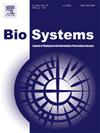Impacts of a high-glucose diet or starvation on microRNA-transcription factor networks in Caenorhabditis elegans through Boolean mathematical modeling
IF 1.9
4区 生物学
Q2 BIOLOGY
引用次数: 0
Abstract
We analyzed the expression of the genes of Caenorhabditis elegans that are components of the Insulin/Insulin-like growth factor (IIS) and Target of Rapamycin (TOR) signaling pathways, and the microRNAs that regulate their expression. These genes are involved in longevity and their expression is differentially regulated under starvation conditions and high-glucose diets. We inferred the regulatory network from experimental data and analyzed its dynamics using Boolean networks. The regulatory network contains 26 nodes and 60 regulatory interactions. Upon examining their dynamic behavior, we discovered the presence of six fixed-point attractors. Two attractors align with the physiological response of a normal diet and another two align with gene expression associated with starvation conditions. In the starvation conditions, pro-longevity genes were found to be active, which explains the positive effect observed when the worms are grown in these conditions. One of the attractors is consistent with the gene expression found when worms are grown in high-glucose diets. In this case, anti-longevity genes were expressed, as found in the literature. Interestingly, we found another attractor in the high-glucose diet in which pro-longevity genes were observed, suggesting that under some circumstances a high-glucose diet can have a positive effect on lifespan. We also performed simulations of knock-out (KO) experiments of critical components of the network, such as LET-7, DAF-2, DAF-16, SKN-1, HLH-30, PHA-4, and DAF-15 (a component of the TORC1 complex) and our results were similar to the reported experimental evidence.
通过布尔数学模型研究高糖饮食或饥饿对秀丽隐杆线虫microrna -转录因子网络的影响
我们分析了秀丽隐杆线虫中作为胰岛素/胰岛素样生长因子(IIS)和雷帕霉素靶蛋白(TOR)信号通路组成部分的基因的表达,以及调节其表达的microrna。这些基因与长寿有关,在饥饿和高糖饮食条件下,它们的表达受到不同的调节。我们从实验数据中推断出调节网络,并使用布尔网络分析其动态。监管网络包含26个节点和60个监管相互作用。在检查它们的动态行为后,我们发现了六个定点吸引子的存在。两个吸引子与正常饮食的生理反应相一致,另外两个与饥饿条件相关的基因表达相一致。在饥饿条件下,促长寿基因被发现是活跃的,这解释了蠕虫在这种条件下生长时观察到的积极影响。其中一个吸引因子与蠕虫在高糖饮食中生长时发现的基因表达一致。在这种情况下,正如文献中发现的那样,表达了抗长寿基因。有趣的是,我们在高糖饮食中发现了另一个吸引因素,其中观察到有利于长寿的基因,这表明在某些情况下,高糖饮食可以对寿命产生积极影响。我们还对该网络的关键组成部分进行了敲除(KO)实验模拟,如LET-7、DAF-2、DAF-16、SKN-1、HLH-30、PHA-4和DAF-15 (TORC1复合物的一个组成部分),我们的结果与报道的实验证据相似。
本文章由计算机程序翻译,如有差异,请以英文原文为准。
求助全文
约1分钟内获得全文
求助全文
来源期刊

Biosystems
生物-生物学
CiteScore
3.70
自引率
18.80%
发文量
129
审稿时长
34 days
期刊介绍:
BioSystems encourages experimental, computational, and theoretical articles that link biology, evolutionary thinking, and the information processing sciences. The link areas form a circle that encompasses the fundamental nature of biological information processing, computational modeling of complex biological systems, evolutionary models of computation, the application of biological principles to the design of novel computing systems, and the use of biomolecular materials to synthesize artificial systems that capture essential principles of natural biological information processing.
 求助内容:
求助内容: 应助结果提醒方式:
应助结果提醒方式:


